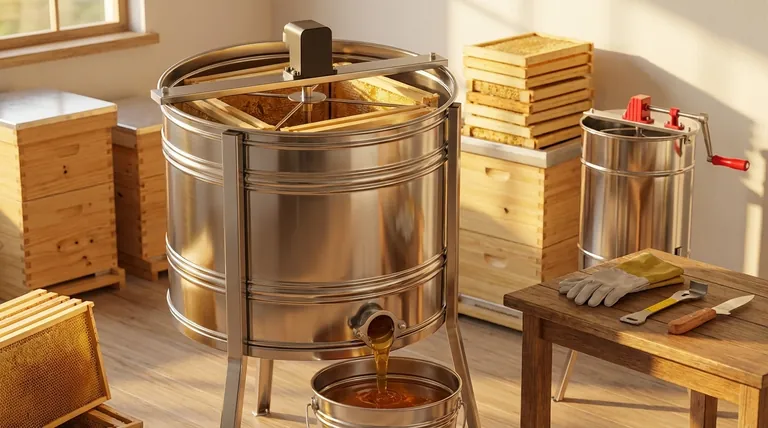From a purely mechanical standpoint, manual honey extractors are generally more durable. Their simple construction with fewer moving parts—typically just a crank and gears—means there are significantly fewer points of failure compared to their electric counterparts.
The question of durability is less about choosing between manual and electric and more about prioritizing the right factors. The true durability of any honey extractor is determined primarily by its material and build quality, not its power source.

The Core Elements of Extractor Durability
To make a wise investment, you must look beyond the power source and evaluate the fundamental components that dictate an extractor's lifespan and reliability.
Material: The Foundation of Longevity
The single most important factor for durability is the material used for the drum and basket. Food-grade stainless steel is the industry standard for good reason.
Stainless steel offers superior resistance to rust and corrosion from the natural acidity of honey. It is also non-porous, making it easy to clean and sanitize, which prevents contamination and degradation over time.
Design Simplicity vs. Mechanical Complexity
This is where the manual versus electric debate truly lies. Simplicity often correlates directly with a longer, maintenance-free lifespan.
A manual extractor has a very simple system. The risk of failure is confined to the hand crank or the simple gears, which are typically robust and easy to repair or replace.
An electric extractor introduces complexity. It adds a motor, power controller, wiring, and other electronic components. While highly efficient, each of these parts is a potential point of failure that requires proper care and maintenance.
Build Quality: The Details That Matter
Beyond the core material, overall construction is critical. Pay close attention to the quality of the welds, the stability of the legs or base, and the thickness (gauge) of the stainless steel.
A well-built extractor feels solid and does not wobble during operation. High-quality welds ensure structural integrity and prevent leaks, while a sturdy base is essential for safety and stability, especially when spinning heavy frames of honey.
Understanding the Trade-offs
Choosing an extractor involves balancing durability with operational efficiency. Each type presents a distinct set of advantages and compromises.
The Manual Extractor's Limitation
The trade-off for the exceptional durability and simplicity of a manual extractor is physical effort and time. For a beekeeper with only a few hives, this is a perfectly acceptable compromise.
However, for larger operations, the labor required can become a significant bottleneck, making it an impractical choice despite its reliability.
The Electric Extractor's Maintenance Burden
The clear advantage of an electric extractor is speed and efficiency, which saves immense amounts of labor. This is essential for any medium-to-large-scale beekeeper.
The trade-off is the responsibility of ownership. These machines are not "set it and forget it." They require periodic inspection and maintenance of the motor and electrical systems to ensure a long and productive service life. A high-quality electric model that is properly cared for can last for many years.
How to Choose a Truly Durable Extractor
Your final decision should be guided by your operational needs, with a constant focus on material and build quality.
- If your primary focus is maximum simplicity and minimal failure points: Choose a manual extractor made from high-quality, food-grade stainless steel from a reputable manufacturer.
- If your primary focus is long-term reliability for a larger operation: Invest in a heavy-duty electric extractor with a proven motor and robust, thick-gauge stainless steel construction.
- For any scale of beekeeping: Always prioritize build quality—inspecting welds, leg stability, and materials—over secondary features.
Ultimately, a well-built extractor is the most durable, regardless of how it is powered.
Summary Table:
| Factor | Impact on Durability | Key Consideration |
|---|---|---|
| Material | Highest Impact | Food-grade stainless steel is essential for rust and corrosion resistance. |
| Power Source | Defines Maintenance Needs | Manual: Fewer moving parts, simpler. Electric: More efficient but requires motor maintenance. |
| Build Quality | Critical for Longevity | Inspect welds, leg stability, and steel thickness for a solid, wobble-free unit. |
Ready to invest in a durable honey extractor built for commercial demands?
At HONESTBEE, we supply heavy-duty, food-grade stainless steel extractors designed for the rigors of commercial apiaries and distributors. Our focus on superior materials and robust construction ensures your equipment is a long-term asset, maximizing your operational efficiency and ROI.
Contact our wholesale team today to discuss your specific needs and get a quote.
Visual Guide

Related Products
- HONESTBEE 3-Frame Manual Acrylic Honey Extractor
- 2 Frame Stainless Steel Manual Honey Spinner Extractor for Beekeeping
- Stainless Steel 3 Frame Manual Honey Extractor Spinner for Bee Honey Extraction
- Electric 8 Frame Honey Spinner Extractor Equipment for Beekeeping
- 6 Frame Manual Stainless Steel Honey Extractor Beekeeping Equipment
People Also Ask
- How often do beekeepers collect honey? Maximize Your Hive's Sustainable Yield
- How do you manually extract honey? Choose the Best Method for Your Hive
- What size honey extractor do I need? Match Frame Capacity to Your Hives for Maximum Efficiency
- What equipment is used for honey harvest? Essential Tools for Every Beekeeper
- How to extract honey by hand? A Guide to Crush & Strain vs. Manual Extractors



















